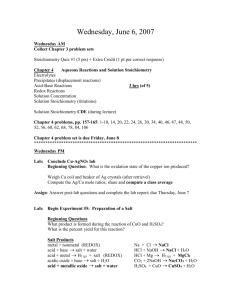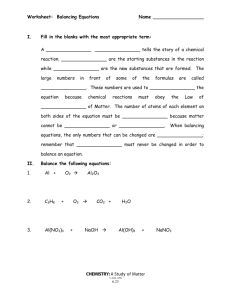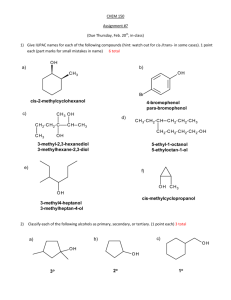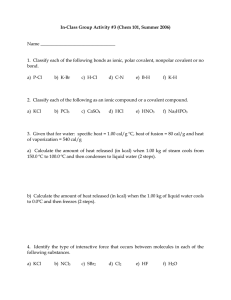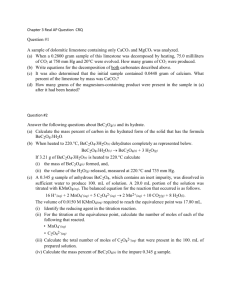3.16 Oxidizing and Reducing Agents
advertisement
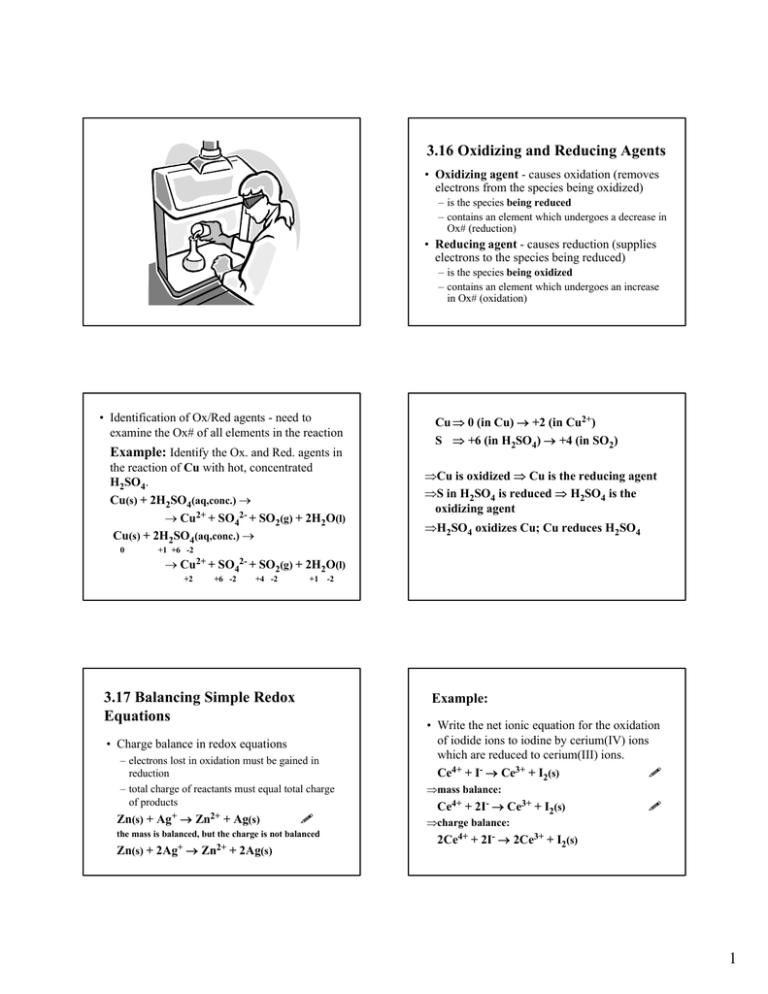
3.16 Oxidizing and Reducing Agents • Oxidizing agent - causes oxidation (removes electrons from the species being oxidized) – is the species being reduced – contains an element which undergoes a decrease in Ox# (reduction) • Reducing agent - causes reduction (supplies electrons to the species being reduced) – is the species being oxidized – contains an element which undergoes an increase in Ox# (oxidation) • Identification of Ox/Red agents - need to examine the Ox# of all elements in the reaction Example: Identify the Ox. and Red. agents in the reaction of Cu with hot, concentrated H2SO4. Cu(s) + 2H2SO4(aq,conc.) → → Cu2+ + SO42- + SO2(g) + 2H2O(l) Cu(s) + 2H2SO4(aq,conc.) → 0 Cu ⇒ 0 (in Cu) → +2 (in Cu2+) S ⇒ +6 (in H2SO4) → +4 (in SO2) ⇒Cu is oxidized ⇒ Cu is the reducing agent ⇒S in H2SO4 is reduced ⇒ H2SO4 is the oxidizing agent ⇒H2SO4 oxidizes Cu; Cu reduces H2SO4 +1 +6 -2 → Cu2+ + SO42- + SO2(g) + 2H2O(l) +2 +6 -2 +4 -2 +1 -2 3.17 Balancing Simple Redox Equations Example: • Charge balance in redox equations – electrons lost in oxidation must be gained in reduction – total charge of reactants must equal total charge of products Zn(s) + Ag+ → Zn2+ + Ag(s) ! the mass is balanced, but the charge is not balanced Zn(s) + 2Ag+ → Zn2+ + 2Ag(s) • Write the net ionic equation for the oxidation of iodide ions to iodine by cerium(IV) ions which are reduced to cerium(III) ions. Ce4+ + I- → Ce3+ + I2(s) ! ⇒mass balance: Ce4+ + 2I- → Ce3+ + I2(s) ! ⇒charge balance: 2Ce4+ + 2I- → 2Ce3+ + I2(s) 1 3.18 Classifying Reactions • Redox – change in Ox# of elements – products • carbon dioxide and water for combustion • ionic compound for metal + nonmetal • Precipitation – exchange of ions between two soluble salts – formation of an insoluble product – solubility rules • Neutralization – transfer of protons from an acid to a base – products are salt (cation from base, anion from acid) and/or water (sometimes gas formation) Fig. 3.33 • Example: Balance the equation of the reaction ⇒formation of elements (check Ox#): between ammonia gas and and copper(II) oxide with products nitrogen, copper and liquid water. Identify the reaction type. ⇒change in (Ox#) → Redox reaction ⇒skeletal equation: 2NH3(g) + 3CuO(s) → N2(g) + 3Cu(s) + 3H2O(l) -3 +2 0 0 NH3(g) + CuO(s) → N2(g) + Cu(s) + H2O(l) ! ⇒balanced equation: 2NH3(g) + CuO(s) → N2(g) + Cu(s) + H2O(l) ! 2NH3(g) + CuO(s) → N2(g) + Cu(s) + 3H2O(l) ! 2NH3(g) + 3CuO(s) → N2(g) + Cu(s) + 3H2O(l) ! 2NH3(g) + 3CuO(s) → N2(g) + 3Cu(s) + 3H2O(l) Example: Predict the products of the reaction between sodium carbonate and hydrobromic acid. ⇒HBr is a strong acid, Na2CO3 is a salt → probably a proton transfer reaction ⇒ Na2CO3 is a salt of a weak acid → gas formation 2HBr(aq) + Na2CO3(aq) → NaBr(aq) + H2CO3(aq) H2CO3(aq) → CO2(g) + H2O(l) ⇒gas formation reaction 2HBr(aq) + Na2CO3(aq) → 2NaBr(aq) +CO2(g) + + H2O(l) 2H+ + 2Br- + 2Na+ + CO32- → 2Na+ + 2Br- + + CO2(g) + H2O(l) ⇒net ionic equation: 2H+ + CO32- → CO2(g) + H2O(l) ⇒consider the hydronium ions: 2H3O+ + CO32- → CO2(g) + 3H2O(l) 2 Assignments: • Homework: Chpt. 3/3, 5, 7, 11, 15, 19, 23, 27, 31, 33, 35, 37, 39, 45, 49, 51, 53, 59, 61, 73 • Student companion: 3.1, 3.4, 3.5, 3.6 3
